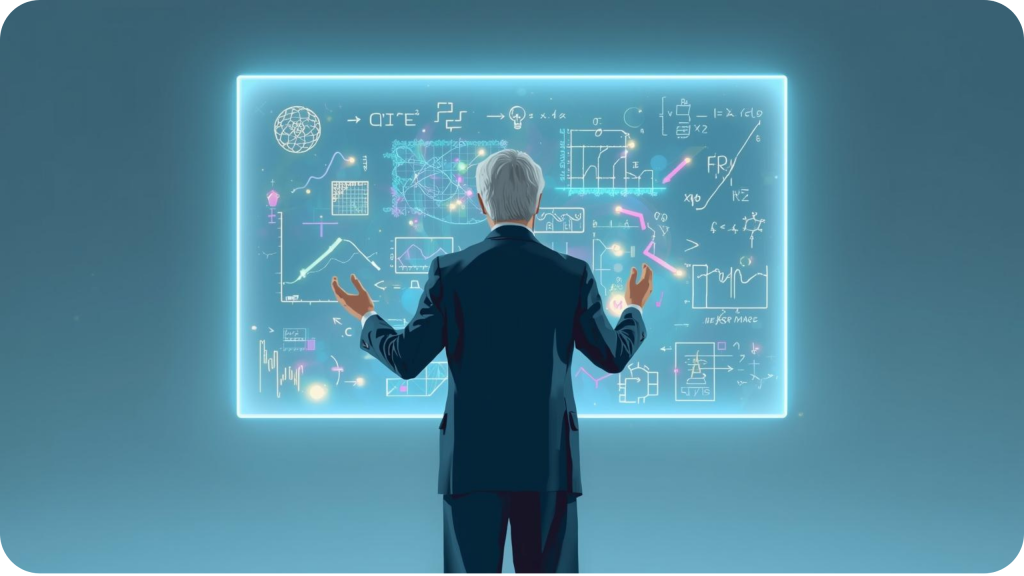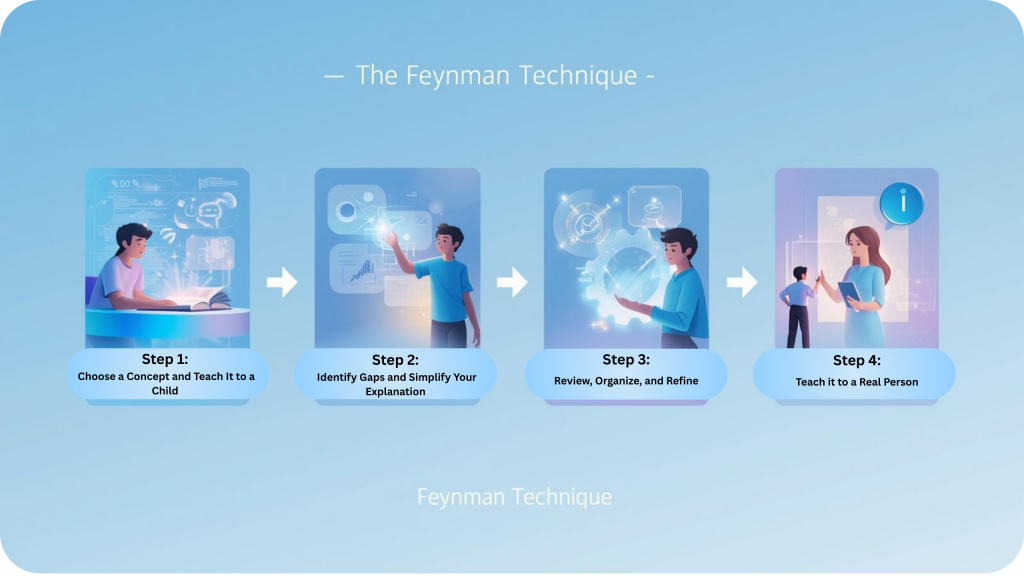
Beyond Memorization: Using AI to Achieve Feynman-Level Understanding
How many times have you read a textbook chapter, felt you understood it, only to completely blank when trying to explain it to a classmate or answer an exam question? This common frustration is a sign of illusory competence—the belief that you know something when you’ve only familiarized yourself with it. The solution isn’t studying harder; it’s studying smarter with a method designed to expose what you don’t know and build genuine, deep understanding.
Enter the Feynman Technique, a powerful learning strategy named after Nobel Prize-winning physicist Richard Feynman. Renowned for his ability to explain complex ideas like quantum physics in simple, intuitive terms, Feynman believed that true mastery of a subject is demonstrated by the ability to explain it to a beginner.
This ultimate guide will deconstruct the Feynman Technique, walk you through its four simple steps, and reveal how you can leverage modern AI tools within the StudyWizardry app to implement this method more efficiently and effectively than ever before. Stop pretending to understand—start mastering.
Who Was Richard Feynman and Why Was He a Genius of Explanation?
Richard Feynman wasn’t just a brilliant theoretical physicist; he was a master teacher. His legendary lectures, compiled in books like “The Feynman Lectures on Physics,” are celebrated for their clarity, humor, and ability to strip away jargon to reveal the elegant core of scientific principles.
Feynman held a profound belief: “If you can’t explain something in simple terms, you don’t understand it.” This principle is the very heart of the Feynman Technique. It forces you to move beyond memorizing terms and formulas to actually grappling with the meaning and relationships between ideas. It’s the difference between knowing the name of something and truly knowing something.

The 4 Steps of the Feynman Technique: A Blueprint for Deep Learning
The Feynman Technique’s power lies in its stunning simplicity. You only need a blank sheet of paper and a willingness to be honest about your knowledge gaps.
Step 1: Choose a Concept and Teach It to a Child
Take a sheet of paper and write the name of the concept you want to master at the top—for example, “Photosynthesis,” “The Pythagorean Theorem,” or “Supply and Demand.” Now, write an explanation of this concept as if you were teaching it to a 12-year-old. This is crucial.
Why a child? Teaching to a hypothetical child forces you to:
- Avoid jargon and technical terms. You must use simple, plain language.
- Focus on the core ideas rather than getting lost in complicated details.
- Create analogies and metaphors that make abstract concepts relatable.
Example: Instead of writing, “Photosynthesis is a biogeochemical process wherein phototrophic organisms convert light energy into chemical energy,” you’d write, “Photosynthesis is how plants eat. They use sunlight, which is their food, to turn water and air into the sugar that helps them grow.”
Step 2: Identify Gaps and Simplify Your Explanation
This is the most critical step. As you write your simple explanation, you will inevitably hit a roadblock. You’ll realize you can’t clearly explain why the light is needed or what the “air” (carbon dioxide) specifically does. These roadblocks are not failures; they are the gold mines of the learning process.
- Circle these gaps in your understanding. They are the specific areas you need to review.
- Go back to your textbook, class notes, or source material and research only those gaps.
- Simplify your explanation further based on your new understanding. The goal is to create an explanation so clear that it leaves no room for ambiguity.

Step 3: Review, Organize, and Refine
Now, take your newly refined explanation and organize it into a coherent, logical narrative. Read it out loud. Does it flow? Does it make sense? If you stumble over a part, that’s another indicator of a remaining gap.
Refine the language until it is smooth and effortless to deliver. This process of organizing and verbalizing strengthens the neural pathways associated with the knowledge, moving it from passive recognition to active recall.
Step 4: (Optional) Teach it to a Real Person
The final test is to teach the concept to an actual person—a friend, a family member, or a study partner. Their questions will be unpredictable and will force you to think about the concept from new angles, further solidifying your understanding. If they can understand your explanation, you have truly mastered the topic.
Supercharging the Feynman Technique with StudyWizardry
While the Feynman Technique is powerful on its own, manually managing it for multiple subjects can be time-consuming. This is where StudyWizardry’s AI-powered toolkit transforms this classic method into a seamless, integrated part of your study workflow.
1. The AI Note Maker: Your Digital Feynman Canvas
The first step of the Feynman Technique requires a blank slate. StudyWizardry’s AI Note Maker is the perfect digital canvas.
-
How it works: Instead of a physical notebook, create a new note for your chosen concept (e.g., “Cell Mitosis”).
-
The AI Advantage: As you write your simple explanation, use the AI to instantly rephrase complex sentences into simpler language. If you’re stuck on a jargon-filled definition from your textbook, paste it into the Note Maker and prompt the AI: “Explain this in simple terms as if to a 12-year-old.” This helps you build the foundational explanation faster.
2. From Passive Notes to Active Recall with Flashcards and Quizzes
The core of the Feynman Technique is active recall—forcing your brain to retrieve information. StudyWizardry automates this.
-
AI Flashcard Generator: Once you have a solid, simplified explanation in your note, use the Flashcard Generator to instantly create a deck of flashcards. The AI can generate question-and-answer pairs based on your note’s content. For example:
-
Front: What is the main purpose of mitosis?
-
Back: To create two new cells that are identical to the original parent cell, for growth and repair.
-
-
Quiz/Test Generator: Take it a step further. Generate a quick practice quiz from your notes. This helps you identify gaps (Step 2) by testing your knowledge in a different format, ensuring you understand the concept well enough to answer questions, not just explain it.

3. The AI Study Planner: Scheduling Your Feynman Reviews
A single session with the Feynman Technique is effective, but to combat the Forgetting Curve, you need to revisit your simplified explanations. StudyWizardry’s AI Study Planner automates this review process using Spaced Repetition.
-
How it works: After you create your “Feynman Notes” and associated flashcards, the AI Study Planner can schedule regular review sessions for them.
-
The Benefit: You don’t have to remember when to review your notes on “The French Revolution” or “Cognitive Dissonance.” The planner will notify you at the optimal time to quickly re-explain the concept to yourself, ensuring the knowledge is transferred to your long-term memory. This combines the deep understanding of Feynman with the long-term retention power of spaced repetition.
4. The PDF & Video Summarizer: Building Your Base Knowledge Faster
Before you can explain a concept simply, you need to understand it from your source material. StudyWizardry’s PDF & Video Summarizer accelerates this initial learning phase.
-
How it helps: Upload a dense textbook chapter or a complex lecture video. The AI will provide a concise summary, highlighting key points and definitions. This gives you a strong foundation to begin Step 1, preventing you from feeling overwhelmed by raw, unstructured information.
Feynman vs. Other Popular Study Methods
| Study Method | Core Approach | Best For | How StudyWizardry Enhances It |
|---|---|---|---|
| The Feynman Technique | Achieving deep conceptual understanding by teaching in simple terms. | Mastering complex theories, preparing for essays and oral exams. | AI Note Maker for simplification, Flashcards/Quizzes for gap identification, Study Planner for spaced reviews. |
| Spaced Repetition | Optimizing memory retention by reviewing information at increasing intervals. | Memorizing vocabulary, formulas, dates, and facts. | Built-in algorithm in the Study Planner and Flashcard system automatically schedules reviews for maximum efficiency. |
| Pomodoro Technique | Maintaining focus and preventing burnout by using timed work sessions. | All types of studying, especially long sessions. | Integrated Pomodoro Timer helps you structure your Feynman sessions into focused sprints. |
| Blurting Method | Quickly assessing knowledge by writing down everything you know about a topic. | Initial review after a lecture, identifying major gaps before deep diving. | AI Note Maker provides a quick canvas to “blurt,” which can then be organized and refined into a Feynman explanation. |
Common Challenges & How to Overcome Them
Challenge 1: “I get stuck on Step 2 because my source material is too confusing.”
-
-
Solution: Use StudyWizardry’s PDF Summarizer first to get a clearer overview. Then, try explaining the summary in your own words. The AI can also help paraphrase confusing paragraphs.
-
Challenge 2: “It feels too slow. I don’t have time to do this for every topic.”
-
-
Solution: You don’t have to! Reserve the full Feynman Technique for the most difficult, foundational concepts in your course. For smaller facts, use regular flashcards. The time invested in mastering a core concept will save you hours of re-learning later.
-
Challenge 3: “My explanation still sounds messy even after reviewing.”
-
-
Solution: This is normal. Use the “Explain it to a 12-year-old” prompt in the AI Note Maker to clean up your language. The act of refining is where learning happens.
-
Conclusion: From Superficial to Super Understanding
The Feynman Technique is more than a study hack; it’s a fundamental shift in how we approach learning. It replaces the illusion of knowledge with the power of true comprehension. By committing to simplicity and relentlessly seeking out your gaps, you build a robust and flexible understanding that will serve you well in exams and beyond.
Ready to transform how you learn? Don’t just memorize—understand.
Download StudyWizardry now and use the AI Note Maker and integrated tools to apply the Feynman Technique to your toughest subjects. Turn complexity into clarity and achieve the academic mastery you deserve.
[Download StudyWizardry on the App Store]
[Get StudyWizardry on Google Play]
Absolutely not! The Feynman Technique is incredibly versatile. You can use it to understand complex theories in history (e.g., the causes of the Cold War), economics (e.g., inflation), literature (e.g., a book's central theme), or even philosophical concepts. Any topic that requires deep understanding, not just rote memorization, is a perfect candidate.
Re-writing notes is often a passive process. You can copy information without processing its meaning. The Feynman Technique is intensely active. It forces you to reconstruct knowledge from scratch using your own neural pathways, which immediately highlights what you haven't internalized. It's the difference between copying a map and drawing one from memory.
Yes, it's fantastic for group study! Have each person prepare a Feynman explanation for a different concept and then teach it to the group. The questions from your peers will help everyone identify gaps and see the material from different perspectives.




